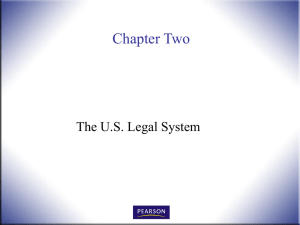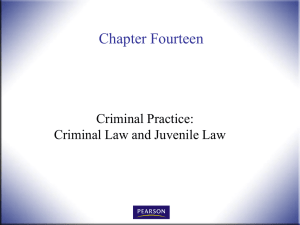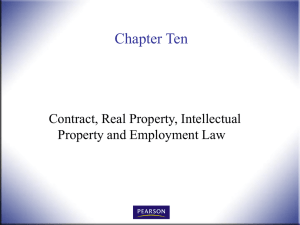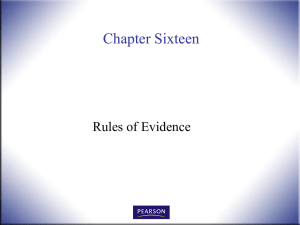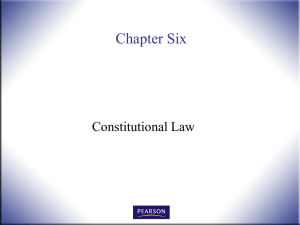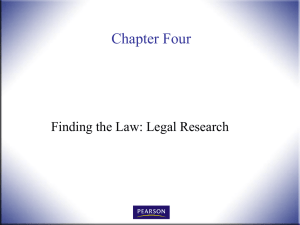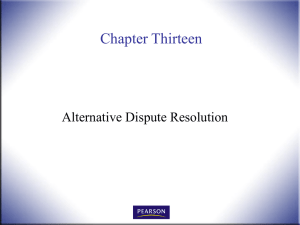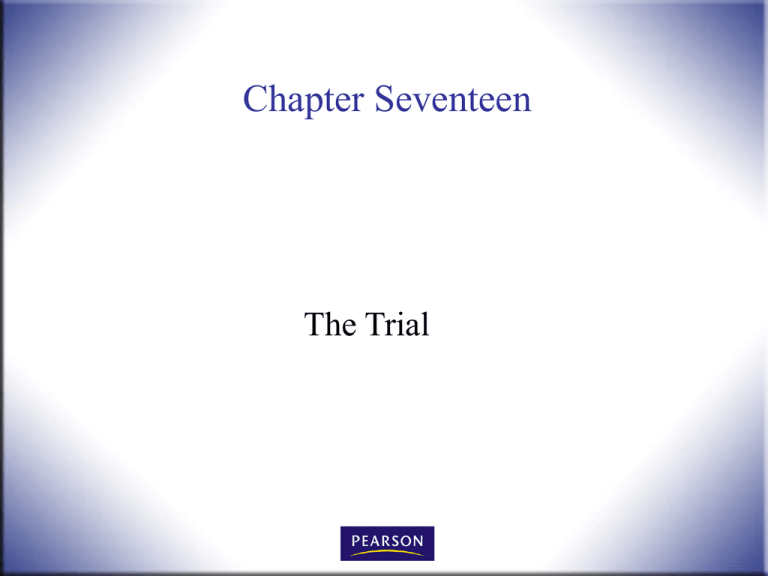
Chapter Seventeen
The Trial
Trial Participants
Judge
Plaintiff’s Attorney
Defendant’s Attorney
Court Reporter
Court Clerk
Jury
Court Deputy/Bailiff
Introduction to Law, 4th Edition
Hames and Ekern
2
© 2010 Pearson Higher Education,
Upper Saddle River, NJ 07458. • All Rights Reserved.
Pre-Trial Motions
Motion for Summary Judgment/Adjudication
May be on all issues, or just a few. Those issues not
included/adjudicated in motion remain for trial.
Motions in Limine
Evidentiary issues
Amending the complaint
Trial procedure issues
Etc.
Introduction to Law, 4th Edition
Hames and Ekern
3
© 2010 Pearson Higher Education,
Upper Saddle River, NJ 07458. • All Rights Reserved.
The Trial Brief
A written document that might contain a
summary of the facts, issues, rules and
analysis used by a court and a
comparison with a client’s facts
Introduction to Law, 4th Edition
Hames and Ekern
4
© 2010 Pearson Higher Education,
Upper Saddle River, NJ 07458. • All Rights Reserved.
Jury Selection
(some vocabulary)
Jury Questionnaire
Jury Panel
Voir Dire
Excused for Cause
Peremptory Challenge
Introduction to Law, 4th Edition
Hames and Ekern
5
© 2010 Pearson Higher Education,
Upper Saddle River, NJ 07458. • All Rights Reserved.
Burden of Proof
(civil case)
The burden of proof is on the Plaintiff
The Plaintiff must prove:
that a civil wrong was committed and
that a preponderance of the evidence
shows that the defendant is liable for that
wrong
Introduction to Law, 4th Edition
Hames and Ekern
6
© 2010 Pearson Higher Education,
Upper Saddle River, NJ 07458. • All Rights Reserved.
Burden of Proof
(criminal)
In a criminal case, the prosecutor must
prove:
1. that a crime has been committed
and
2. that the evidence shows that the
defendant is guilty beyond a
reasonable doubt.
Introduction to Law, 4th Edition
Hames and Ekern
7
© 2010 Pearson Higher Education,
Upper Saddle River, NJ 07458. • All Rights Reserved.
Plaintiff’s Role at Trial
Opening
Statement
Examination of
Witnesses
Redirect
Examination
CrossExamination
Closing
Argument
Introduction to Law, 4th Edition
Hames and Ekern
8
© 2010 Pearson Higher Education,
Upper Saddle River, NJ 07458. • All Rights Reserved.
Defendant’s Role at Trial
Opening
Statement
CrossExamination
Examination of
Witnesses
Redirect
Examination
Closing
Argument
Introduction to Law, 4th Edition
Hames and Ekern
9
© 2010 Pearson Higher Education,
Upper Saddle River, NJ 07458. • All Rights Reserved.
Motions During Trial
Mistrial
Motion for Nonsuit (on all or some of the claims)
Defendant is only party able to bring this motion
Motion for Directed Verdict (either party)
Voluntary dismissal
Amend pleadings to conform to proof
Recess/continuance
Reopen Case in Chief
Contempt
Introduction to Law, 4th Edition
Hames and Ekern
10
© 2010 Pearson Higher Education,
Upper Saddle River, NJ 07458. • All Rights Reserved.
Jury Instructions
Jury instructions provide jurors with the
law applicable to the claims and defenses
presented in a particular case. The jury is
then bound to accept and apply this "law"
to the facts (as it determines from the
evidence) in arriving at a verdict.
Introduction to Law, 4th Edition
Hames and Ekern
11
© 2010 Pearson Higher Education,
Upper Saddle River, NJ 07458. • All Rights Reserved.
Jury Deliberations
Deliberations take place in private
Sometimes juries are sequestered
In most cases the jury reaches a
decision
Once the jury reaches a verdict, the
court reconvenes
Introduction to Law, 4th Edition
Hames and Ekern
12
© 2010 Pearson Higher Education,
Upper Saddle River, NJ 07458. • All Rights Reserved.

